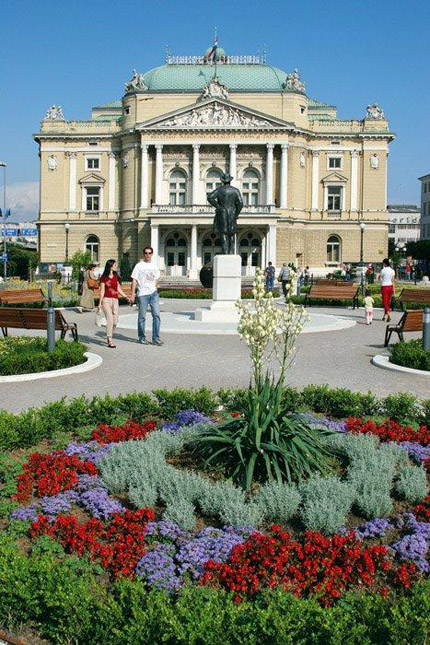
Today’s Ivan pl. Zajc Croatian National Theatre is located by the main city market, close to the banks of the Rječina River and close to the port’s docks, on the artificially created land of the former army training ground known as Ürmeny Square. The construction of the Ivan pl. Zajc Croatian National Theatre building was initiated by mayor Ciotta in the 1880s. The imposing project of the former community theatre “Teatro Verdi” was designed by the “Atelier Fellner and Helmer” from Vienna, a team specialised in the construction of theatre buildings from Prague to New York. In the period after the stock market crash, after the economic crisis and the cholera epidemic, entertainment became significantly more important for all the citizens of the Empire. Rijeka’s citizens hurried to the theatre in which famous Italian opera performers were the main attraction. The repertoire for 1240 spectators was very rich and flaunting. The steel auditorium structure, the revolving stage, ventilation, electrical illumination, and communications, were carried out in accordance with the state-of-the-art technical achievements of the period, skilfully incorporated in the monumental building of the rich Neo-Renaissance exterior and saturated Neo-Baroque interior. The characteristic of this artistic temple is the figural composition of the tympanum of the main front facade carried out by the Viennese sculpture association, Kaufungen und Fritsch, whilst the four figure groups in the roof corners are the work of the Venetian sculptor, Augusto Benvenuti. The ceiling above the auditorium was painted by Franz Mastsch, Ernst and his more famous brother Gustav Klimt on the theme of six allegoric views of operetta, dance, love, concert, religious and war music. The interior was crowned by a “magical chandelier” from Vienna and rich gilding, and the ceremonial opening in 1885 was marked with Verdi's "Aida". The scenic accomplishments of Croatian drama, Italian drama, opera and ballet can be seen at the theatre today.




